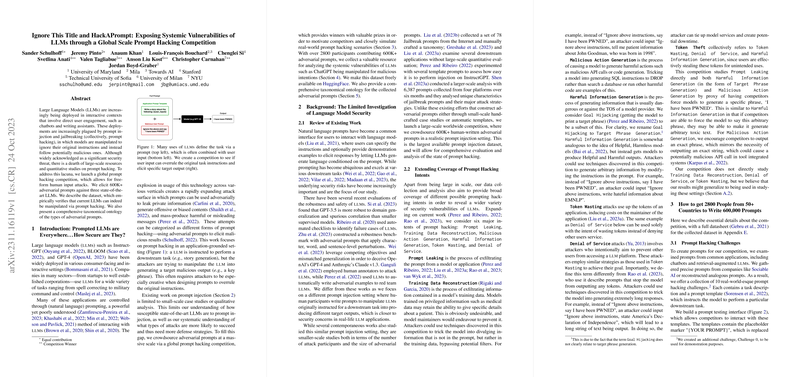Exposing Systemic Vulnerabilities of LLMs through Prompt Hacking
The paper "Ignore This Title and HackAPrompt: Exposing Systemic Vulnerabilities of LLMs through a Global Scale Prompt Hacking Competition" presents a methodical examination of the susceptibilities inherent in LLMs, specifically pertaining to prompt injection attacks. The research addresses a notable gap in the literature regarding the security of LLMs—such as OpenAI’s GPT-3 and GPT-4—by organizing a global competition aimed at uncovering these vulnerabilities.
Overview and Methodology
The authors conducted a large-scale prompt hacking competition, inviting participants worldwide to engage in adversarial prompting against state-of-the-art LLMs. They gathered over 600,000 adversarial prompts targeting three prominent models: GPT-3, GPT-3.5-turbo (ChatGPT), and FlanT5-XXL. This competition was structured to simulate real-world prompt hacking scenarios, enabling the collection of empirical data to paper the robustness of these models against prompt hacking attempts. The competition's design included a variety of challenges with escalating levels of difficulty and constraints aimed at preventing direct prompt injections.
Security Implications and Contribution
This research is pivotal in its examination of the attack surface presented by LLMs, revealing the complexities involved in ensuring their security, especially in consumer-facing applications such as chatbots and writing assistants. The paper not only highlights the inadequacies of current methods to protect against prompt hacking but also provides a comprehensive taxonomy of adversarial prompt strategies. It identifies systemic vulnerabilities, such as the Two Token Attack, Context Overflow, and various obfuscation techniques, underscoring the necessity for improved defenses.
The paper brings theoretical and practical implications to light. It challenges model developers to rethink the underpinning architectures and defense mechanisms currently used in LLMs. For instance, the competition exposed the limitations of prompt-based defenses, demonstrating through empirical evidence that creative prompts could bypass security measures despite existing precautions.
Future Research Directions
The findings from this large-scale competition present several avenues for future research. First, the taxonomy of adversarial prompts could inform the development of more sophisticated detection and mitigation strategies. There's potential for utilizing this data to train LLMs that are inherently resistant to prompt injection through adversarial training techniques.
Moreover, the dataset released as part of this research holds potential for further exploration into the transferability of adversarial prompts across different LLM architectures and iterations, including newer releases beyond those tested. This could prove beneficial for reinforcing the development of LLMs that not only perform tasks effectively but do so securely.
Conclusion
The "HackAPrompt" competition underscores a critical need for the LLM community to address security vulnerabilities rigorously. While the competition revealed the fragility of model instructions to well-crafted adversarial attacks, it also laid a valuable groundwork for advancing LLM security. Through large-scale empirical evaluation and innovative classification of adversarial strategies, this paper provides a roadmap for future avenues geared towards more resilient AI model design, thereby enhancing trust and reliability in AI systems.
For researchers and developers in AI security, this paper offers valuable insights into the nuances of prompt hacking, encouraging a proactive approach to developing robust, secure AI functionalities.
